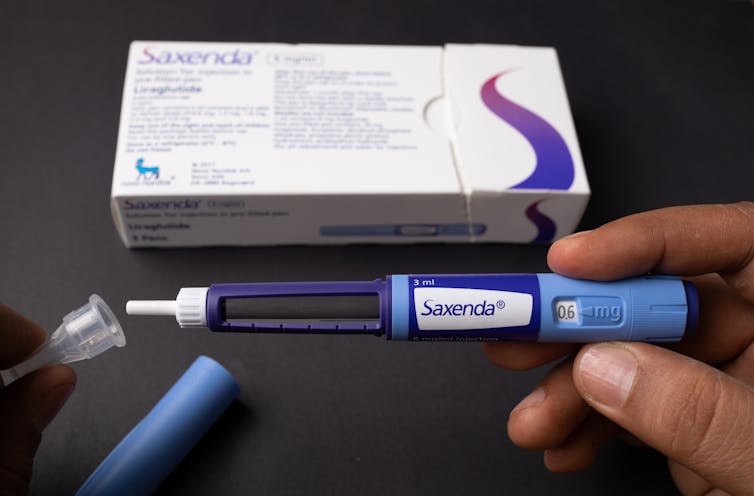Ozempic’s cousin drug liraglutide is about as expensive. But how does it stack up?
Fourteen years ago, semaglutide’s cousin the big drug (Ozempic and Wegovy) came to the market. The drug, liraglutide, is sold under the brand names Victoza and Saxenda.
The patents for Victoza and Saxenda have now expired. So some drug companies are working to produce “generic” versions. This is probably a fraction of the current cost, which is around A$400 per month.
So how does liraglutide compare to semaglutide?
How do these drugs work?
Liraglutide was not developed as a weight loss treatment. Like semaglutide (Ozempic), it was originally used to treat type 2 diabetes.
The group of drugs liraglutide and semaglutide belong to are known as GLP-1 mimetics, which means they mimic the natural hormone GLP-1. This hormone is released in your small intestine as a result of food and works in many ways to improve the way your body deals with glucose (sugar).
How do they stop hunger?
Liraglutide works on several areas of the unconscious part of your brain, especially the hypothalamus, which controls metabolism, and the parts of the brain responsible for transferring the nutrient status of your body to the hypothalamus.
Its actions here seem to reduce hunger in two different ways. First, it helps you feel full sooner, making smaller meals more satisfying. Second, it changes your “motivational process” for food, which means it reduces the amount of food you want.
The original form of Liraglutide, designed to treat type 2 diabetes, was marketed as Victoza. Its ability to reduce body weight was noticed soon after it entered the market.
Soon after, a powerful product, called Saxenda, was released, aimed at weight loss in obese people.
How much weight can you lose with liraglutide?
People respond differently and will lose weight differently. But here, we will note the average weight loss users can expect. Some will lose more (sometimes more), others will lose less, and a small part will not respond.
The first drug to mimic GLP-1 was exenatide (Bayetta). It is still available to treat type 2 diabetes, but there are currently no generics. Exenatide provides some weight loss, but this is moderate, usually around 3-5% of body weight.
For liraglutide, those using the medicine to treat obesity will use the stronger one (Saxenda), which usually provides a 10% weight loss.
Semaglutide, which has a stronger form called Wegovy, usually results in 15% weight loss.
The newest GLP-1-mimicking drug on the market, tirzepatide (Mounjaro for type 2 diabetes and Zepbound for weight loss), results in weight loss of approximately 25% of body weight.
What happens when you stop taking them?
Despite the effectiveness of these drugs in helping to lose weight, they do not seem to change people’s body weight.
So, in most cases, when people stop using them, they regain their original weight.

Mohammed_Al_Ali/Shutterstock
What is the dose and how often do you need to take it?
Liraglutide (Victoza) for type 2 diabetes is well the same drug as Saxenda for weight loss, but Saxenda is a higher dose.
Although the target of each structure is the same (GLP-1 receptor), for the control of glucose in type 2 diabetes, liraglutide must reach (mainly) the pancreas.
But to achieve weight loss, it must reach the parts of the brain. This means crossing the blood-brain barrier – and not all of them do, which means there’s a lot to take in.
All current forms of GLP-1 mimicking drugs are injections. This will not change when liraglutide generics hit the market.
However, they differ in how often they need to be vaccinated. Liraglutide is a once-daily injection, while semaglutide and tirzepatide are once-weekly. (That makes semaglutide and tirzepatide very attractive, but we won’t see semaglutide as a generic until 2033.)
What are the side effects?
Because these drugs all have the same purpose in the body, they often have similar side effects.
The most common are a series of gastrointestinal problems including nausea, vomiting, sweating, constipation and diarrhea. These occur, in part, because these medications slow the movement of food through the stomach, but they are generally controlled by gradually increasing the dose.
Recent clinical data suggest that delayed evacuation may be problematic for some people and may increase the risk of food entering the lungs during surgery, so it is important to inform the doctor yours if you are taking any of these drugs.
Because these are injections, they can also lead to injection site care.

Halfpoint/Shutterstock
During clinical trials, there were some reports of thyroid disease and pancreatitis (inflammation of the pancreas). However, it is not clear that these can be caused by drugs that mimic GLP-1.
In animals, drugs that mimic GLP-1 have been found to adversely alter fetal growth. There is currently no controlled clinical trial data on their use during pregnancy, but based on animal data, these medications should not be used during pregnancy.
Who can use them?
GLP-1-mimicking drugs for weight loss (Wegovy, Saxenda, Zepbound/Mounjaro) are approved for use by people with obesity and are intended to be used only in conjunction with diet and exercise.
These drugs must be prescribed by a doctor and for obesity they are not covered by the Pharmaceutical Benefits Scheme, which is one of the reasons why they are expensive. But in the long run, generic versions of liraglutide may be cheaper.
#Ozempics #cousin #drug #liraglutide #expensive #stack